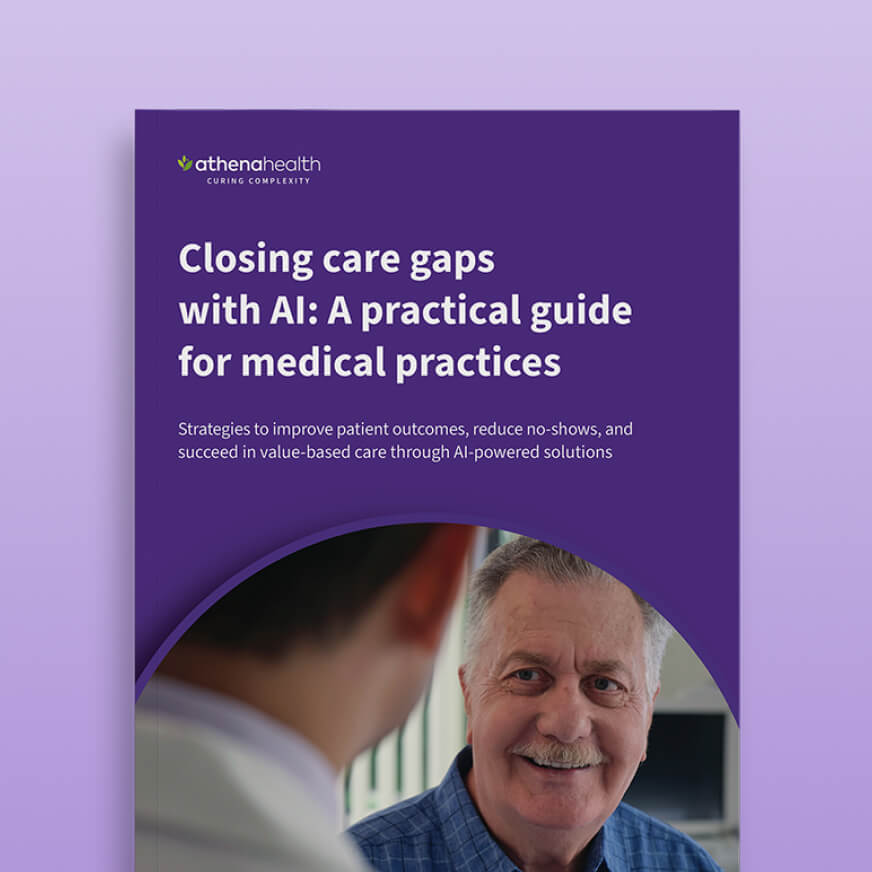5 ways to increase patient retention and fill scheduling gaps

Building patient loyalty and strategies for patient retention
Maintaining a steady patient roster is a challenge for many healthcare organizations, whether you’re hoping to add new patients, retain existing patients, or struggling to get patients to show up for the appointments they’ve scheduled. More than one-third (37%) of medical groups report patient no-show rates have increased in 2023.1
Patient loyalty is key, yet challenging to achieve in today’s environment. Many patients expect a patient experience that matches the ease and convenience of interacting with consumer businesses like Amazon or Uber. If you want to keep those patients engaged with your healthcare organization and attract new patients, you need to invest in improving the patient experience. Patient engagement tools can help fill any gaps in your schedule, increase current revenue and future revenue potential, and grow your business.2
Let’s take a look at how your organization can give patients the experience they expect and the care they need, in a way that strengthens your business.
Attract patients by meeting them where they are — online
Patients expect their healthcare experience to be digitally enabled, with 26% of patients saying they are willing to switch to a new provider for high-quality digital services.3
A digital experience starts with being visible online. Patients today often turn to online reviews and provider networks to find a new clinician. If you want to attract new patients, start by auditing your digital presence. Update your website, and make sure it’s easy for new patients to not only find you, but to understand your organization’s philosophy and willingness to engage via technology.
As part of that process, review your digital patient engagement tools, making sure you have a consumer-friendly patient experience from the time a patient searches for a new clinician all the way through post-appointment follow ups.
Patients increasingly expect their interactions with your organization to be as frictionless as their consumer interactions. They want to be able to check their lab results, reschedule an appointment, send a direct message to their provider, and even attend a telehealth appointment — all from their mobile device. Digital activation can also help patients better manage their health. And when patients are more engaged in their health, that can lead to better health outcomes, in turn4 — an important metric for your organization in an increasingly value-based care world.
Perform outreach campaigns to help strengthen the patient-practice relationship and improve patient satisfaction
It’s not enough to only communicate with patients when they’re in your office. Your patients are like you — they have busy lives and often are juggling many responsibilities in their day-to-day. Expecting them to book another appointment, pay copays, and remember to check in for their next visit without any reminders is unrealistic. Plus, patients today expect to be able to contact their clinician via a patient portal when questions pop up between visits.
More than a third (39%) of healthcare consumers believe a good digital interaction has a major influence on the patient experience.2 Effective communication between in-office visits improves patient engagement and satisfaction, while directing patients to take the actions you want.
Automated appointment reminders via text message or email are a great way to help reduce no-shows with no additional administrative work required by your team. In the near future, AI-native athenaOne® will include an AI-enabled, two-way texting tool called Patient Conversations. This tool will allow practice staff to send and receive messages within athenaOne, with AI agents also having the capacity to respond directly to inbound message with quick, personalized replies to commonly asked questions and general inquiries. Additionally, automated patient outreach campaigns can be tailored to encourage patients to schedule their next appointment, or remind patients about outstanding bills, so you can collect more of what you’re owed with less work.
Care gap outreach campaigns also offer the opportunity to engage with patients to help close gaps in care, like annual wellness visits, immunizations, cancer screenings, and more. These campaigns not only help you take better care of your patients by getting them the care they need, but in doing so, they can also help you succeed in any VBC contracts that require care gap closure or measure clinical outcomes.
Creating outreach campaigns via patient engagement tools introduces new efficiencies by cutting down on administrative work and time spent on patient outreach. And stronger communication between you and your patients builds stronger relationships, improving patient satisfaction and loyalty in the process.
Offer self-serve options to increase efficiency for patients and your staff
Patients want to feel like they’re in control of their care. For many, this means they want to be able to do things themselves, with more than 60% of healthcare consumers expecting to be able to change or schedule a healthcare appointment online.5 Many healthcare organizations have heard that message loud and clear, with 66% of medical practices adding or improving patient self-service tools like scheduling, online bill pay, and more in the past year.6
You might be leaving revenue on the table if you’re not offering self-service tools like digital payments: practices that use online payment solutions have a 32% higher patient pay yield than practices that do not.7 Instead of coming to an appointment 20 minutes early to fill out paperwork or waiting on hold, many patients would rather schedule appointments or make payments on their own schedule, whenever and wherever it’s convenient for them. If you aren’t meeting this need, patients may go elsewhere for care.
Self-service options are a win-win for patients and for your organization. Self-scheduling, for example, requires less manual work for your staff, reduces the number of calls they field about scheduling questions patients would largely prefer to handle themselves, and allows you to reallocate staff time to strategic growth initiatives. And when it’s easier for patients to make appointments, they could be more likely to schedule, show up, and keep coming back.
Practices can also utilize AI agents to reinforce self-service and fill open appointment slots. athenaOne will ultimately feature a Waitlist Scheduling tool that can automatically identify and message patients to help fill open schedule appointment slots—including for same-day cancellations.
Effective communication between in-office visits improves patient engagement and satisfaction, while directing patients to take the actions you want.
Enhance data sharing to reduce frustration and improve the quality of care
Just as clinicians are frustrated by lack of data sharing, patients are, too. Your organization might be contributing to that same frustration if your EHR and patient engagement tools don’t automatically share information with each other.
Patients often waste time filling out the same information over and over — online, and then again in the office. That frustration is a liability at a time when 50% of patients say that a bad digital experience with a healthcare provider ruins the entire care experience with that provider.2 Integrated patient experience solutions automatically update information in the patient chart and can ensure that information is available through the patient portal, too. This ensures clinicians have the information they need, without your staff having to manually enter or track it.
Self check-in is one way this comes to life. Digital check-in allows patients to fill out forms at home on their own schedule, in a place where they have access to all the medical information they need, from medications to personal and family medical history. An integrated self check-in tool can save time8 for both the patient and the staff: when information auto-populates in the patient chart, that eliminates duplicative work. Reducing patient frustration via a seamless check-in and data sharing experience helps contribute to patient satisfaction, reducing the likelihood that they’ll go elsewhere for care.
Engaged, satisfied patients support the longevity of your practice
What resonates most for your patient population depends on several factors, like your specialty and possibly even geographic location. The needs of a cardiology organization that primarily deals with an older patient population are very different than a pediatrics practice where you’re communicating with digitally native parents.
But digital activation, proactive outreach, self-service tools, and better data sharing can help improve the patient experience across the board, and your organization will reap additional reward from these initiatives. Streamlining the patient experience creates efficiencies for your staff to pivot from repetitive, manual work to strategic business objectives. And focusing on patient retention strategy ensures steady revenue for your business, as you attract new patients to help your organization grow.
More closing care gaps resources
Continue exploring
1. MGMA, August 2023, Stat Poll.
2. Deloitte, 2021, Opportunities for consumer-facing technologies in health systems: Building a better health care experience.
3. Accenture, August 2020, How can leaders make recent digital health gains last?
4. McKinsey, March 2022, The next frontier of care delivery in healthcare.
5. 2021 McKinsey Provider Customer Experience Survey.
6. MGMA, October 2022, Stat Poll.
7. Based on athenahealth data as of June 2023. Patient Pay Yield is the percentage of patient balance collected within 6 months of the date of service.
8. MGMG, May 2022, Digital check-in can boost patient satisfaction and efficiency amid staffing shortages.
Note: some content was updated in October 2025 for accuracy and relevance.










